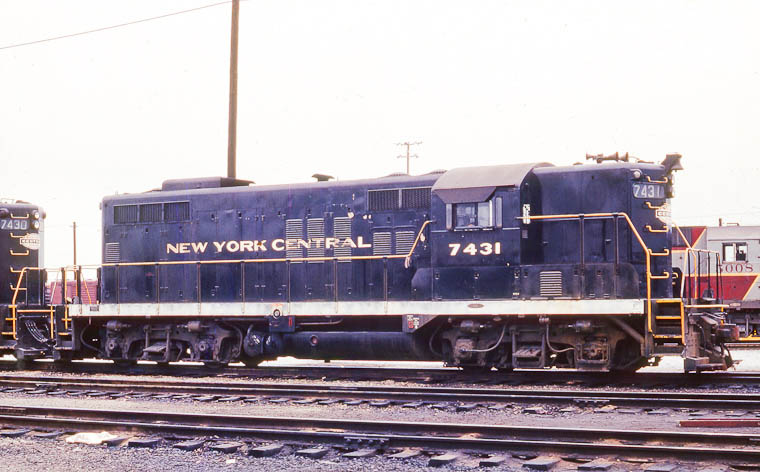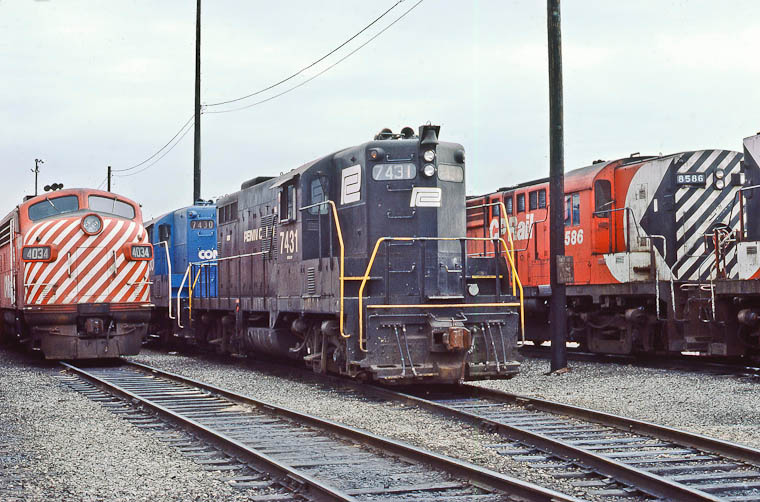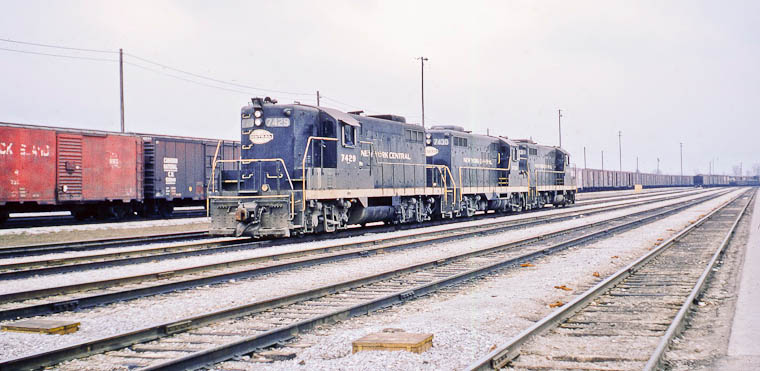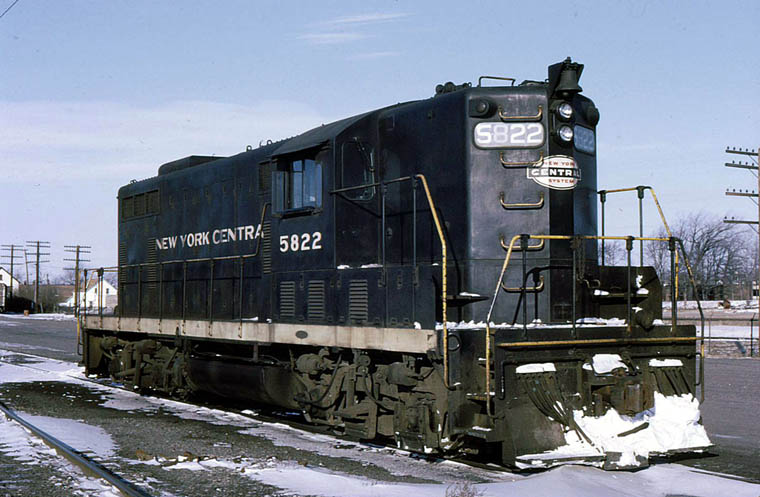CPR-TH&B-MC Toronto-Hamilton-Welland-Niagara Falls-Buffalo
Lance Brown

NYC 7431 Toronto Yard October 13, 1966 D.W.Hately/Bruce Chapman
Collection

PC 7431 hiding CONRAIL 7430. Toronto Yard 5/1977 Gary R. Zuters/Bruce
Chapman Collection

NYC_7429_7430_7431 Toronto Yard 5/1966 Bruce Chapman
The Joint Through Freight Service between Victoria Yard
in Fort Erie and Toronto commenced on January 1, 1931. On August 3,
1932 the service began to operate from Montrose Yard in Niagara Falls.
Originally, CP crews operated train from Toronto into Aberdeen Yard
and then would run van hop to Kinnear to lift the train from Buffalo
and return to Toronto.
The train from Buffalo would terminate at Kinnear Yard and then run
van hop to Aberdeen to lift the train from Toronto and return to Niagara
Falls.
The crewing of the Niagara Falls to Hamilton portion of the train was
split between TH&B and Michigan Central crews on a mileage equalization
basis. The trip between Hamilton and Niagara Falls was 49 miles (39
on TH&B rails, 10 miles on MC rails), so the crewing was split 80%
TH&B and 20% MC for each calendar year.
Under normal circumstances, TH&B crews would operate the train between
Montrose and Kinnear and return commencing January 1 for 292 days, or
until October 19. MC crews would then operate the train between Montrose
and Kinnear and return commencing October 20 for 73 days, or until December
31. The actual number of days the train was manned by each railway was
adjusted each period to allow additional days to compensate for any
trips that were cancelled (weather, stat. holidays, derailments, strikes,
etc) during that period.
On April 1, 1966 a new run through agreement took effect. While the
crewing of the trains remained the same, the operation and equipment
used in the service was altered. Under the new agreement, the TH&B
and NYC each supplied three engines to the service while CP would supply
the vans. Both power and vans would operate with the train the entire
length of the trip between Toronto and Buffalo as opposed to being turned
back at Hamilton as was done previously. In addition, the crews would
swap their trains directly at Kinnear eliminating the use of Aberdeen
and the necessity of both crews operating van hop between the two yards.
In 1972, the mileage equalization agreement between the TH&B and
PC was altered to reflect the new mileages brought about by the Welland
Canal Relocation Project. Under the new agreement the work was split
69% TH&B and 31% PC.
U.S. crews did not operate into Niagara Falls, ON. U.S. road crews operated
this train from Buffalo to Niagara Falls where a Canadian yard crew
from Montrose would take their power across the border to get the train,
or taxi across the border and bring the train across with the U.S. or
TH&B power. It wasn't uncommon for the U.S. power to operate through
to Toronto. (GP-9B's, U-25's, GP-20's, F-7's, GP-38's or whatever other
four axle power brought the train over from Buffalo could be seen operating
straight through to Toronto.)
Once the train was in Montrose, it would be handled by the applicable
TH&B or NYC to Kinnear. Montrose was the home terminal for the TH&B
crews during their operation of the train and the TH&B supplied
two vans as sleeping accomodations at Montrose for their use.
Welland

5822 Welland 1/1971 Paul Mc Grane Collection
The NYC (MCRR) used to have an engine based in Welland
to handle their industrial work and freight shed. In fact, during the
steam era, the NYC engine was kept at the TH&B roundhouse at Coyle
Yard.
The NYC also used to have their own tracks in the TH&B's Coyle Yard,
but they were removed in the early 1930's. Beginning in January 1931,
the TH&B and NYC combined their night Welland assignments into one
joint assignment that lasted until 1956.
Like all other joint TH&B-NYC assignments, crewing was done on an
equalization basis with the equalization being carried out every six
months. Records were kept as to the number of hours the assignment spent
performing work exclusive to either the TH&B or NYC. At the end
of the six month period, the hours would be calculated to determine
the number of days a NYC crew would handle the assignment.
As the bulk of the work was exclusive to the TH&B, the equalization
for the NYC men typically varied between 30 to 50 days every six months
with the remainder of the six month period being worked by TH&B
men.
After the relocation of the Welland Canal in 1972, the PC Welland Assignment
was relocated to the new joint TH&B-PC yard in Wainfleet.
